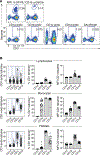CD36 family members are TCR-independent ligands for CD1 antigen-presenting molecules
- PMID: 34172588
- PMCID: PMC8418821
- DOI: 10.1126/sciimmunol.abg4176
CD36 family members are TCR-independent ligands for CD1 antigen-presenting molecules
Abstract
CD1c presents lipid-based antigens to CD1c-restricted T cells, which are thought to be a major component of the human T cell pool. However, the study of CD1c-restricted T cells is hampered by the presence of an abundantly expressed, non-T cell receptor (TCR) ligand for CD1c on blood cells, confounding analysis of TCR-mediated CD1c tetramer staining. Here, we identified the CD36 family (CD36, SR-B1, and LIMP-2) as ligands for CD1c, CD1b, and CD1d proteins and showed that CD36 is the receptor responsible for non-TCR-mediated CD1c tetramer staining of blood cells. Moreover, CD36 blockade clarified tetramer-based identification of CD1c-restricted T cells and improved identification of CD1b- and CD1d-restricted T cells. We used this technique to characterize CD1c-restricted T cells ex vivo and showed diverse phenotypic features, TCR repertoire, and antigen-specific subsets. Accordingly, this work will enable further studies into the biology of CD1 and human CD1-restricted T cells.
Copyright © 2021 The Authors, some rights reserved; exclusive licensee American Association for the Advancement of Science. No claim to original U.S. Government Works.
Figures






Similar articles
-
Diverse antigen presentation by the Group 1 CD1 molecule, CD1c.Mol Immunol. 2013 Sep;55(2):182-5. doi: 10.1016/j.molimm.2012.10.019. Epub 2012 Nov 3. Mol Immunol. 2013. PMID: 23127489 Free PMC article. Review.
-
Group 1 CD1-restricted T cells take center stage.Eur J Immunol. 2011 Mar;41(3):592-4. doi: 10.1002/eji.201141408. Epub 2011 Feb 11. Eur J Immunol. 2011. PMID: 21341260
-
Donor-unrestricted T cells in the human CD1 system.Immunogenetics. 2016 Aug;68(8):577-96. doi: 10.1007/s00251-016-0942-x. Epub 2016 Aug 9. Immunogenetics. 2016. PMID: 27502318 Free PMC article. Review.
-
A Subset of Human Autoreactive CD1c-Restricted T Cells Preferentially Expresses TRBV4-1+ TCRs.J Immunol. 2018 Jan 15;200(2):500-511. doi: 10.4049/jimmunol.1700677. Epub 2017 Dec 13. J Immunol. 2018. PMID: 29237773 Free PMC article.
-
Human gammadelta T cell recognition of lipid A is predominately presented by CD1b or CD1c on dendritic cells.Biol Direct. 2009 Dec 1;4:47. doi: 10.1186/1745-6150-4-47. Biol Direct. 2009. PMID: 19948070 Free PMC article.
Cited by
-
Identification of Key Genes Driving Tumor Associated Macrophage Migration and Polarization Based on Immune Fingerprints of Lung Adenocarcinoma.Front Cell Dev Biol. 2021 Nov 4;9:751800. doi: 10.3389/fcell.2021.751800. eCollection 2021. Front Cell Dev Biol. 2021. PMID: 34805160 Free PMC article.
-
Lipidomic scanning of self-lipids identifies headless antigens for natural killer T cells.Proc Natl Acad Sci U S A. 2024 Aug 20;121(34):e2321686121. doi: 10.1073/pnas.2321686121. Epub 2024 Aug 14. Proc Natl Acad Sci U S A. 2024. PMID: 39141352 Free PMC article.
-
A specialized tyrosine-based endocytosis signal in MR1 controls antigen presentation to MAIT cells.J Cell Biol. 2022 Dec 5;221(12):e202110125. doi: 10.1083/jcb.202110125. Epub 2022 Sep 21. J Cell Biol. 2022. PMID: 36129434 Free PMC article.
-
Glycolipids from the gut symbiont Bacteroides fragilis are agonists for natural killer T cells and induce their regulatory differentiation.Chem Sci. 2023 May 27;14(29):7887-7896. doi: 10.1039/d3sc02124f. eCollection 2023 Jul 26. Chem Sci. 2023. PMID: 37502334 Free PMC article.
-
CD1a and bound lipids drive T-cell responses in human skin disease.Eur J Immunol. 2023 Oct;53(10):e2250333. doi: 10.1002/eji.202250333. Epub 2023 Aug 11. Eur J Immunol. 2023. PMID: 37539748 Free PMC article. Review.
References
-
- Rossjohn J, Gras S, Miles JJ, Turner SJ, Godfrey DI, McCluskey J, T cell antigen receptor recognition of antigen-presenting molecules. Annual review of immunology 33, 169–200 (2015). - PubMed
-
- Godfrey DI, Uldrich AP, McCluskey J, Rossjohn J, Moody DB, The burgeoning family of unconventional T cells. Nature immunology 16, 1114–1123 (2015). - PubMed
-
- Brigl M, Brenner MB, CD1: antigen presentation and T cell function. Annual review of immunology 22, 817–890 (2004). - PubMed
Publication types
MeSH terms
Substances
Grants and funding
LinkOut - more resources
Full Text Sources
Research Materials
Miscellaneous

